The young dracaena Deremskaya is like a bunch of leaves sticking out of the ground. As the stem grows, the adult plant resembles a small palm tree. This is one of the most unpretentious species of dracaena, but it has its own characteristics, without the knowledge of which cultivation will not be successful.
Material Content:
Dracaena Deremskaya: variety description
The trunk of the dracaena of Derema is densely leafy, thick, poorly branched, gradually lignified. Leaves up to half a meter long and up to 5 cm wide, lanceolate.
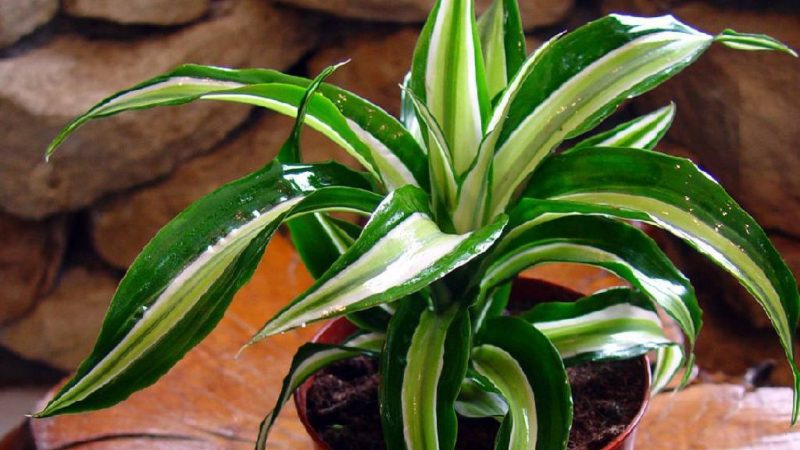
There are varieties with dark green and colorful leaves. In variegated dracaena, white or yellow stripes are visible in the center or on the sides of the leaf. The plant blooms with small red-white flowers collected in brush inflorescences. The smell of flowers is unpleasant.
Reproduction Dracaena Deremensis
Dracaena is propagated by seeds or cuttings in the spring, in March or April. By winter, young plants will get stronger.
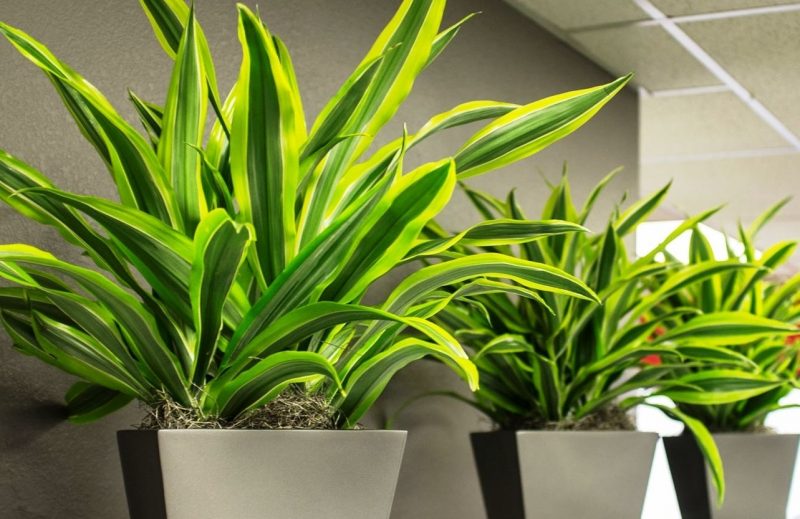
Seed propagation, step by step description:
- The seeds are soaked for a day, you can add "Epin" or "Zircon" to the water.
- Expanded clay is poured into the bottom of pots with a diameter of 10 cm, then soil for seedlings.
- 1 seed is laid out in each pot, deepening it by 1 cm.
- Humidify the soil from a spray bottle.
- Cover with a film or a jar.
- Put in a bright place for germination at a temperature of 25 ° C.
Shoots will appear after about 2 weeks, but can linger and rise only after 3 months.
For propagation by cuttings, pieces of the trunk or apical shoots about 10 cm long are taken. They are rooted in water or soil. In place of the cut of the cuttings, dracaena appears new shoots from the side buds.
Home Care
Dracaena does not like too high air temperature, at 32 ° C in the summer she will suffer from overheating. It is better to rearrange the plant deep into the room and spray it daily.
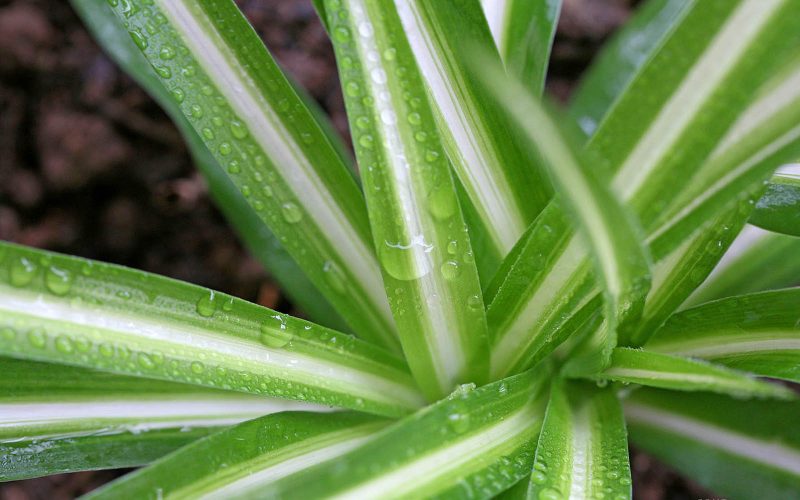
In winter, it is advisable to keep dracaena away from heating radiators; you can take it out to the insulated balcony. Air temperature should not be lower than 15 ° C.
Dracaena Deremskaya with green leaves is the most shade-tolerant. Lighting should be bright, but diffuse. At noon on the southern windowsills, it is advisable to shade the dracaena so that burns do not appear on the leaves. With a lack of lighting, the trunk is greatly extended, the lower leaves quickly fall off. To maintain a decorative look, use illumination.
- Watering should be plentiful in summer and winter if the room temperature is above 24 ° C. It is watered immediately after drying of the top soil layer to a depth of 5 cm. With a cool winter content, watering is reduced, the soil in the pot should not remain wet.
- For fertilizer use complex preparations. The ratio of the main nutrient components (nitrogen, phosphorus and potassium) should be 3: 1: 3. The “Stimulus” preparation is suitable for ornamental-deciduous plants or “Agricola” for ficuses.
- Drazen is not required high humidity. If the room temperature is below 25 ° C, frequent spraying is not necessary. You can arrange a hot shower for the plant with a water temperature of 50 ° C, covering the ground with a bag. This will be a good prevention of spider mites.
Read also:dracaena marginata: home care
Plant rejuvenation
Dracaena Deremskaya is a large plant, which in room conditions, with good care, can grow to the ceiling. If the lighting is insufficient, the trunk is extended, the lower leaves fall, the dracaena loses its decorative appearance.
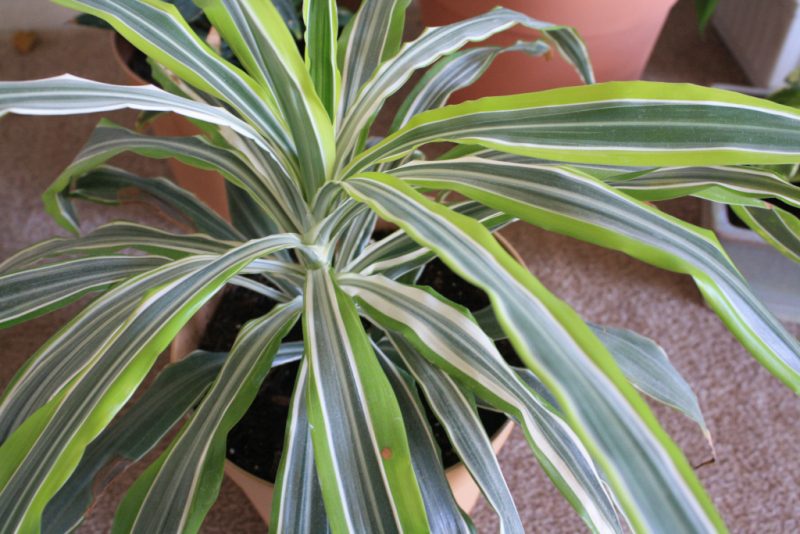
For rejuvenation, trimming the trunk. Cut the apical stem to awaken the side buds, two new shoots should grow under the cut.
The long apical shoot can be divided into several parts and rooted. Even a piece of trunk without leaves will give roots and form a new plant.
Slices sprinkled with crushed activated carbon. If a plant has several trunks, and everything needs to be rejuvenated, they are cut at different heights so that new shoots do not interfere with each other's growth.
How to re-root Dracaena Dracaena
It is necessary to re-root the dracaena if the roots have rotted and there is no way to save the mother plant.

The cut apical stem is well rooted in water with the addition of activated carbon (1 tablet per 1 liter of water). But it is better to root the dracaena in the soil so that the trunk does not rot.
To root dracaena in the soil, cut off part of the trunk or apical shoot. A cut of the handle is treated with a growth stimulator. For planting, take a pot with a capacity of 0.5 to 1 liter with drainage holes.
The substrate for planting is prepared from a mixture of universal soil and sand. You can not add perlite and vermiculite - they contain fluorine, which the plant does not like.
The cuttings are rooted in moist soil by arranging a ventilated greenhouse. The roots appear after about three weeks, after which the greenhouse is removed.
What to do if leaves are curled
If the leaves are curled, it means that a pest has settled on them - a spider mite or a scab. The presence of a tick can be determined by a thin cobweb surrounding a part of the sheet. And scale insects form small brown plaques on leaves and stems, insects suck out plant juice, this can lead to the death of dracaena.
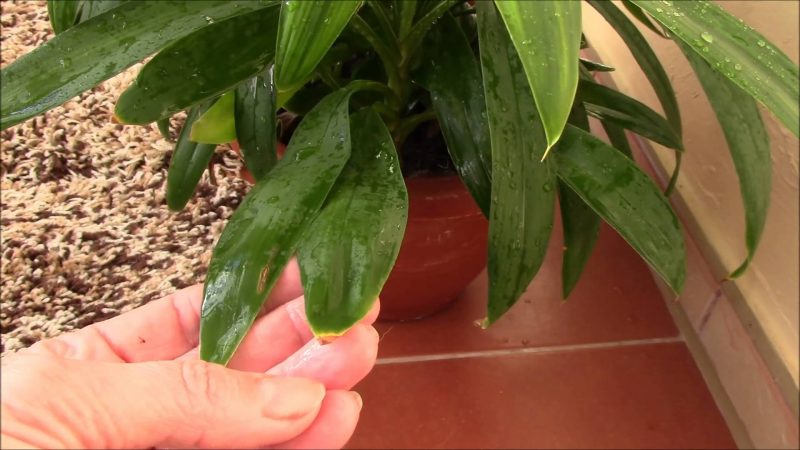
Treatment with acaricides helps against ticks, they fight contact scars with systemic or systemic insecticides. For the prevention of diseases, you can spray the plant with tincture of tobacco.
Why do the tips of the leaves turn black
The tips of the leaves of dracaena often turn black during the heating season, when the air is dry in the room. Wide leaves, which evaporate a lot of moisture, are especially sensitive to low humidity.
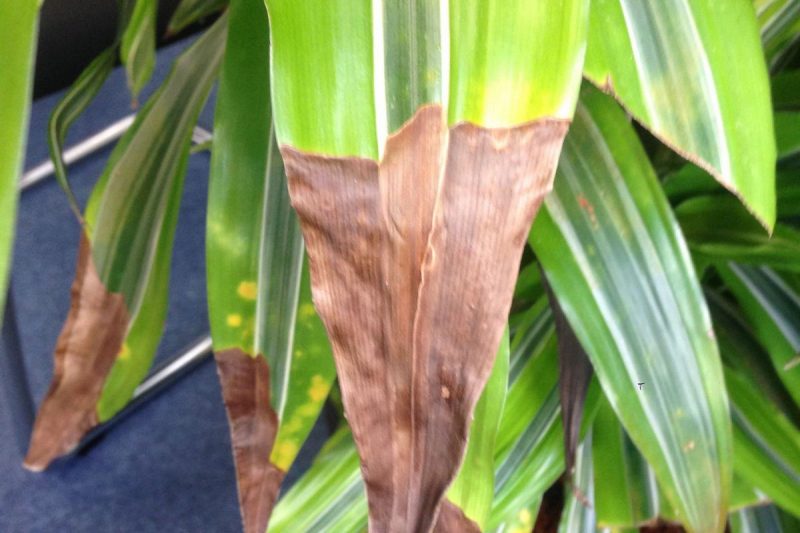
Necrosis of the edge of the leaf plate may occur if the pH of the soil is below 6 units or there is a lot of fluorine in the water for irrigation.
Dracaenas are very sensitive to the quality of irrigation water, it is advisable not only to uphold it, but also pass it through a filter. Superphosphates should not be contained in the soil and fertilizers, they contain a lot of fluorine.
Dracaena, unlike many houseplants, does not need a winter period of rest. It is convenient to grow it at home, it looks decorative year round, thanks to the lush, green foliage.












